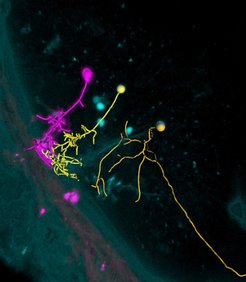Illuminating neural pathways in the living brain

Using light alone, scientists from the Max Planck Institute of Neurobiology in Martinsried are now able to reveal pairs or chains of functionally connected neurons under the microscope. The new optogenetic method, named Optobow, allows probing the pathways along which information flows by targeted activation of individual neurons and monitoring the responses of neighboring cells. The shape of the cells and their contact points are also revealed – even in dense tissue in which the thin fibers of thousands of cells are interwoven. With Optobow, it is thus possible to discover individual components of functional circuits in the living brain.
Modern methods provide increasingly detailed insights into the structure and functions of the brain. It is now possible to observe under the microscope when and where neurons are active during a particular task, such as sensory perception or behavior. However, it is still largely impossible to establish whether the active cells are connected to each other and to identify the sequence in which they exchange information. To date, such information could only be obtained, in part and with considerable effort, using electrophysiology and electron microscopy methods.
With electrophysiology, the activity of neighboring cells is measured using very thin, hollow needles, which serve as electrodes. These are inserted into the brain through holes in the skin and the skull of the animal. However, it is almost impossible to record activity from very small, densely clustered or deep-lying neurons, and it is also difficult to trace long connection pathways between neurons. Moreover, impulses from only one, or few cells, can be recorded at a time. With modern electron microscopy processes (connectomics), all neurons and their connections in a fixed brain are recorded, layer by layer, by a scanning electron microscope and then reconstructed on a computer. Although this method provides a fantastically detailed snapshot of the neural wiring pattern, the information about the dynamic transmission of nerve impulses in the living brain is lost. Both of these approaches thus have clear limitations. “We were looking for a way to observe the connections and transmission of information between nerve cells in the active brain without killing or disrupting the brain,” explains Dominique Förster. Motivated by this quest, Förster and his colleagues from Herwig Baier’s Department at the Max Planck Institute of Neurobiology developed the Optobow method.
